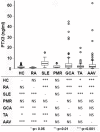PTX3 Intercepts Vascular Inflammation in Systemic Immune-Mediated Diseases
- PMID: 31191526
- PMCID: PMC6548810
- DOI: 10.3389/fimmu.2019.01135
PTX3 Intercepts Vascular Inflammation in Systemic Immune-Mediated Diseases
Erratum in
-
Corrigendum: PTX3 Intercepts Vascular Inflammation in Systemic Immune-Mediated Diseases.Front Immunol. 2019 Jul 24;10:1755. doi: 10.3389/fimmu.2019.01755. eCollection 2019. Front Immunol. 2019. PMID: 31396240 Free PMC article.
Abstract
PTX3 is a prototypic soluble pattern recognition receptor, expressed at sites of inflammation and involved in regulation of the tissue homeostasis. PTX3 systemic levels increase in many (but not all) immune-mediated inflammatory conditions. Research on PTX3 as a biomarker has so far focused on single diseases. Here, we performed a multi-group comparative study with the aim of identifying clinical and pathophysiological phenotypes associated with PTX3 release. PTX3 concentration was measured by ELISA in the plasma of 366 subjects, including 96 patients with giant cell arteritis (GCA), 42 with Takayasu's arteritis (TA), 10 with polymyalgia rheumatica (PMR), 63 with ANCA-associated systemic small vessel vasculitides (AAV), 55 with systemic lupus erythematosus (SLE), 21 with rheumatoid arthritis (RA) and 79 healthy controls (HC). Patients with SLE, AAV, TA and GCA, but not patients with RA and PMR, had higher PTX3 levels than HC. PTX3 concentration correlated with disease activity, acute phase reactants and prednisone dose. It was higher in females, in patients with recent-onset disease and in those with previous or current active vasculitis at univariate analysis. Active small- or large- vessel vasculitis were the main independent variables influencing PTX3 levels at multivariate analysis. High levels of PTX3 in the blood can contribute to identify an increased risk of vascular involvement in patients with systemic immune-mediated diseases.
Keywords: ANCA associated small vessel vasculitis; PTX3; Takayasu arteritis; autoimmunity; giant cell arteritis; intravascular immunity; lupus; rheumatoid arthritis.
Figures




Similar articles
-
PTX3 in small-vessel vasculitides: an independent indicator of disease activity produced at sites of inflammation.Arthritis Rheum. 2001 Dec;44(12):2841-50. doi: 10.1002/1529-0131(200112)44:12<2841::aid-art472>3.0.co;2-6. Arthritis Rheum. 2001. PMID: 11762945
-
Systemic pentraxin-3 levels reflect vascular enhancement and progression in Takayasu arteritis.Arthritis Res Ther. 2014 Nov 14;16(6):479. doi: 10.1186/s13075-014-0479-z. Arthritis Res Ther. 2014. PMID: 25394473 Free PMC article.
-
Detection of Anti-Pentraxin-3 Autoantibodies in ANCA-Associated Vasculitis.PLoS One. 2016 Jan 21;11(1):e0147091. doi: 10.1371/journal.pone.0147091. eCollection 2016. PLoS One. 2016. PMID: 26797217 Free PMC article.
-
Serum procalcitonin in systemic autoimmune diseases--where are we now?Semin Arthritis Rheum. 2010 Oct;40(2):176-83. doi: 10.1016/j.semarthrit.2009.10.004. Epub 2010 Feb 4. Semin Arthritis Rheum. 2010. PMID: 20132965 Review.
-
[Granulomatous vasculitides and vasculitides with extravascular granulomatosis].Z Rheumatol. 2022 Sep;81(7):558-566. doi: 10.1007/s00393-022-01249-7. Epub 2022 Aug 12. Z Rheumatol. 2022. PMID: 35962194 Review. German.
Cited by
-
Perspectives on long pentraxin 3 and rheumatoid arthritis: several potential breakthrough points relying on study foundation of the past.Int J Med Sci. 2021 Mar 3;18(8):1886-1898. doi: 10.7150/ijms.54787. eCollection 2021. Int J Med Sci. 2021. PMID: 33746606 Free PMC article. Review.
-
Pentraxin 3 is more accurate than C-reactive protein for Takayasu arteritis activity assessment: A systematic review and meta-analysis.PLoS One. 2021 Feb 2;16(2):e0245612. doi: 10.1371/journal.pone.0245612. eCollection 2021. PLoS One. 2021. PMID: 33529185 Free PMC article.
-
Macrophage expression and prognostic significance of the long pentraxin PTX3 in COVID-19.Nat Immunol. 2021 Jan;22(1):19-24. doi: 10.1038/s41590-020-00832-x. Epub 2020 Nov 18. Nat Immunol. 2021. PMID: 33208929
-
Cardio-metabolic-related plasma proteins reveal biological links between cardiovascular diseases and fragility fractures: a cohort and Mendelian randomisation investigation.EBioMedicine. 2025 Mar;113:105580. doi: 10.1016/j.ebiom.2025.105580. Epub 2025 Feb 6. EBioMedicine. 2025. PMID: 39919333 Free PMC article.
-
Blood Biomarkers for Monitoring and Prognosis of Large Vessel Vasculitides.Curr Rheumatol Rep. 2021 Feb 10;23(3):17. doi: 10.1007/s11926-021-00980-5. Curr Rheumatol Rep. 2021. PMID: 33569633 Free PMC article. Review.
References
Publication types
MeSH terms
Substances
LinkOut - more resources
Full Text Sources
Other Literature Sources
Medical
Miscellaneous

